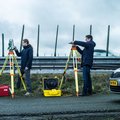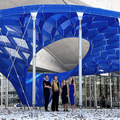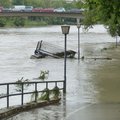Latest news
17 November 2022
Roderik Lindenbergh & Mieke Kuschnerus laser scan data set of Kijkduin

Nature Portfolio’s Scientific Data Journal published an article written by Sander Vos, Katharina Anders, Mieke Kuschnerus, Roderik Lindenbergh, Bernhard Höfle, Stefan Aarninkhof and Sierd de Vries, that describes a 6 month long hourly laser scan survey of the beach-dune system at Kijkduin, The Netherlands. The Netherlands is protected by about 250 kilometers of natural beach-dune systems and understanding the natural variability and resilience is of key importance to protect the Netherlands with the future climate change and sea level rise. The dataset provides information about storm responses and shoreward sand transport which is important for the resilience determination.
16 November 2022
A navigation system with 10 centimetres accuracy

Researchers of Delft University of Technology, Vrije Universiteit Amsterdam and VSL have developed an alternative positioning system that is more robust and accurate than GPS, especially in urban settings. The working prototype that demonstrated this new mobile network infrastructure achieved an accuracy of 10 centimeter.
03 November 2022
Herman Russchenberg doet onderzoek naar wolken: ‘Ze zijn van grote invloed op ons klimaat’

Dat wolken deel uitmaken van het dagelijkse weer, is zo alom bekend dat we ze als een bekend fenomeen beschouwen. Herman Russchenberg van de TU Delft doet onderzoek naar het ontstaan en gedrag van wolken, omdat we juist zo weinig erover weten en het wel van grote invloed is op het klimaat.
01 November 2022
Emission saving construction thanks to 3D-knitting

In front of the prestigious MAXXI Museum in Rome rises an artful structure that attracts attention with its unusual shape and bright blue colour. It is a collaboration between the Block Research Group of ETH Zürich and TU Delft. The pavilion is shaped with a unique knitting work Mariana Popescu created using an algorithm and a knitting machine. With this, she demonstrates that it is possible to make efficient structures with very little building material, which also reduces CO2 emissions. Hardly any formwork is needed, resulting in virtually no construction waste.
01 November 2022
Emission saving construction thanks to 3D-knitting

In front of the prestigious MAXXI Museum in Rome rises an artful structure that attracts attention with its unusual shape and bright blue colour. It is a collaboration between the Block Research Group of ETH Zürich and TU Delft. The pavilion is shaped with a unique knitting work Mariana Popescu created using an algorithm and a knitting machine. With this, she demonstrates that it is possible to make efficient structures with very little building material, which also reduces CO2 emissions. Hardly any formwork is needed, resulting in virtually no construction waste.
25 October 2022
TU Delft in 21st position in THE Engineering & Technology rankings

For the fourth time in a row, TU Delft ranks 21st in the Engineering & Technology rankings of the Times Higher Education Subject Rankings 2023 published today, 25 October. This is the most relevant category for a university of technology like TU Delft.
18 October 2022
Rarest extreme rainstorms will become even more intense

Promovendus Gaby Gründemann berekende de regenval in 2071-2100 voor vier toekomstscenario’s, variërend van een wereld waarin de bevolkingsgroei en de fossiele energiebehoefte blijven toenemen tot een wereld die zich focust op duurzaamheid en een dalende CO2-uitstoot. Hoe dan ook zullen zowel de meest zeldzame buien als de jaarlijkse extreme buien in elk scenario heviger worden.